Toxic Chemical Release Inventory Reporting Forms and Instructions
Toxic Chemical Release Inventory Reporting Forms and Instructions
Toxic Chemical Release Inventory Reporting Forms and Instructions
You also want an ePaper? Increase the reach of your titles
YUMPU automatically turns print PDFs into web optimized ePapers that Google loves.
Facility Eligibility Determination for Submitting an EPCRA Section 313 Report<br />
De Minimis Application to the Processing or<br />
Otherwise Use of a Mixture<br />
The de minimis exemption applies to the processing or<br />
otherwise use of a non-PBT EPCRA section 313 chemical in a<br />
mixture. Threshold determinations <strong>and</strong> release <strong>and</strong> other waste<br />
management calculations begin at the point where the chemical<br />
meets or exceeds the de minimis level. If a non-PBT EPCRA<br />
section 313 chemical is present in a mixture at a concentration<br />
below the de minimis level, this quantity of the substance does<br />
not have to be included for threshold determinations, release<br />
<strong>and</strong> other waste management reporting, or supplier notification<br />
requirements. The exemption will apply as long as the mixture<br />
containing de minimis amounts of a non-PBT EPCRA section<br />
313 chemical never equals or goes above the de minimis limit.<br />
Concentration Ranges Straddling the De Minimis Value<br />
There may be instances in which the concentration of a non-<br />
PBT chemical is given as a range straddling the de minimis<br />
limit. Example 6 illustrates how the de minimis exemption<br />
should be applied in such a scenario.<br />
Example 5: De Minimis Applications to Process <strong>and</strong> Otherwise Use Scenarios for Non-PBT <strong>Chemical</strong>s<br />
There are many cases in which the de minimis “limit” is crossed or recrossed by non-PBT chemicals within a process or<br />
otherwise use scenario. The following examples are meant to illustrate these complex reporting scenarios.<br />
Increasing Concentration To or Above De Minimis Levels During Processing for Non-PBT <strong>Chemical</strong>s<br />
A manufacturing facility receives toluene that contains chlorobenzene at a concentration below its de minimis limit. Through<br />
distillation, the chlorobenzene content in process streams is increased over the de minimis concentration of 1%. From the point<br />
at which the chlorobenzene concentration equals 1% in process streams, the amount present must be factored into threshold<br />
determinations <strong>and</strong> release <strong>and</strong> other waste management estimates. The facility does not need to consider the amount of<br />
chlorobenzene in the raw material when below de minimis levels, i.e., prior to distillation to 1%, when making threshold<br />
determinations. The facility does not have to report emissions of chlorobenzene from storage tanks or any other equipment<br />
associated with that specific process where the chlorobenzene content is less than 1%.<br />
Fluctuating Concentration During Processing for Non-PBT <strong>Chemical</strong>s<br />
A manufacturer produces an ink product that contains toluene, an EPCRA section 313 chemical, below the de minimis level.<br />
The process used causes the percentage of toluene in the mixture to fluctuate: it rises above the de minimis level for a time but<br />
drops below the level as the process winds down. The facility must consider the chemical toward threshold determinations from<br />
the point at which it first equals the de minimis limit. Once the de minimis limit has been met the exemption cannot be taken.<br />
18 <strong>Toxic</strong>s <strong>Release</strong> <strong>Inventory</strong> <strong>Reporting</strong> <strong>Forms</strong> <strong>and</strong> <strong>Instructions</strong>
















